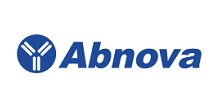
ZFYVE9 recombinant monoclonal antibody, clone R01-0A4



* The price is valid only in USA. Please select country.
-
More Files
- More Functions
-
Specifications
Product Description
Rabbit recombinant monoclonal antibody raised against human ZFYVE9.
Antibody Species
Rabbit
Immunogen
Original antibody is raised against a synthetic peptide corresponding to human ZFYVE9.
Theoretical MW (kDa)
Calculated MW: 156 k
Reactivity
Human
Form
Liquid
Purification
Affinity chromatography
Isotype
IgG
Recommend Usage
Immunohistochemistry (1:50-1:100)
Immunoprecipitation (1:20)
Western Blot (1:500-1:1000)
The optimal working dilution should be determined by the end user.Storage Buffer
In 50mM Tris-Glycine, 150mM NaCl, pH 7.4 (40% glycerol, 0.05% BSA and 0.01% Sodium azide)
Storage Instruction
Store at 4°C. For long term storage store at -20°C.
Aliquot to avoid repeated freezing and thawing.Note
This product contains sodium azide: a POISONOUS AND HAZARDOUS SUBSTANCE which should be handled by trained staff only.
-
Applications
Western Blot
Western blot analysis of Lane 1: HeLa whole cell lysate, Lane 2: A549 whole cell lysate and Lane 3: HL-60 whole cell lysate with ZFYVE9 recombinant monoclonal antibody, clone R01-0A4 (Cat # RAB04446).Immunohistochemistry (Formalin/PFA-fixed paraffin-embedded sections)
Immunoprecipitation
-
Gene Info — ZFYVE9
Entrez GeneID
9372Protein Accession#
O95405Gene Name
ZFYVE9
Gene Alias
MADHIP, NSP, SARA, SMADIP
Gene Description
zinc finger, FYVE domain containing 9
Omim ID
603755Gene Ontology
HyperlinkGene Summary
This gene encodes a double zinc finger (FYVE domain) protein that interacts directly with SMAD2 and SMAD3, and is involved in Alzheimer's disease. SMAD proteins transmit signals from transmembrane serine/threonine kinase receptors to the nucleus. The FYVE domain has been identified in a number of unrelated signaling molecules. This protein functions to recruit SMAD2 to the transforming growth factor-beta receptor. The FYVE domain is required to maintain the normal localization of this protein but is not involved in mediating interaction with SMADs. The C-terminal domain of this protein interacts with the TGFB receptor. This protein is a component of the TGFB pathway that brings the SMAD substrate to the receptor. Three alternatively spliced transcripts encoding distinct isoforms have been found for this gene. [provided by RefSeq
Other Designations
MAD homolog interacting protein|MAD, mothers against decapentaplegic homolog interacting protein, receptor activation anchor|MADH-interacting protein|OTTHUMP00000009739|OTTHUMP00000009740|OTTHUMP00000009741|mothers against decapentaplegic homolog interact
-
Interactomes
-
Pathways
- +1-909-264-1399
+1-909-992-0619
Toll Free : +1-877-853-6098 - +1-909-992-3401
- sales@abnova.com










